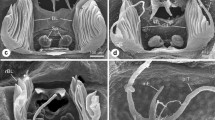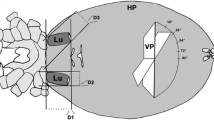Summary
Both Belostoma and Ranatra possess I–II, subepimeral, thoracic subalar, and abdominal subalar air stores. In Belostoma, unlike Ranatra, the subepimeral air store is greatly enlarged, the abdominal subalar store is partially exposed to the water, and a fully exposed ventral abdominal air store is also present. All the air stores of Ranatra are normally concealed.
The mesothoracic and metathoracic spiracles, which open onto the I–II and subepimeral air stores respectively, are of limited permeability. They appear to have less respiratory importance than the large and highly permeable first abdominal spiracles, which lie in the subalar air space and can probably exhale and inhale large amounts of air. The large eighth abdominal spiracles, which lie at the base of the siphon or retractile organ, can also inhale or exhale much air in Ranatra but appear to be mainly exhalant in Belostoma. The smaller second through seventh abdominal spiracles structurally resemble the eighth ones in Belostoma and open onto the ventral abdominal air store. In Ranatra they appear to have no significant respiratory function.
Both genera obtain atmospheric air and give off exhaled air by means of the posterior retractile organ or siphon. The two types of air appear to follow different pathways in the two genera. In Ranatra atmospheric air appears to enter the tracheal system mainly or entirely through the eighth abdominal spiracles and then passes through the first abdominal spiracles into the subalar space. Exhaled air follows the reverse pathway. In Belostoma, however, atmospheric air probably enters the tracheae mainly through the first abdominal spiracles; it is conveyed to these spiracles from the retractile organ through the subalar space or, more indirectly, through the ventral abdominal air store. Air exhaled through the first abdominal spiracles follows the reverse route; the eighth abdominal spiracles can also exhale directly into the base of the retractile organ.
During underwater respiration the abdominal portion of the subalar air store appears to be the main reservoir for oxygen. The subalar oxygen is initially atmospheric, and is supplemented, during submersion, by other sources of oxygen. Belostoma may use its exposed ventral abdominal air store, and its partially exposed abdominal subalar one, as “physical gills”; both these stores communicate with the inhalant first abdominal spiracles. Ranatra, none of whose air stores are normally exposed, appears, to be less capable of utilizing dissolved oxygen, but the considerable amount of atmospheric oxygen in the elongated siphon may be inhaled, during submersion, through the eighth abdominal spiracles.
In both genera the thoracic air stores appear to be of less respiratory importance than the abdominal ones. They do not appear capable of obtaining large amounts of oxygen, and the thoracic spiracles are relatively impermeable. All the air stores, however, serve to protect the spiracles against the entry of water, and also contribute to the body's hydrostatic balance. It is also possible that some of the air stores play a role in pressure reception.
The literature indicates much intergeneric variation in the respiration of Belostomatidae and Nepidae. In the Belostomatidae there is considerable variation in the extent of the ventral abdominal air store and in the roles of the subalar air store and the spiracles. The Nepidae show differences in their ability to utilize dissolved oxygen and in the extent of the subepimeral air store.
Similar content being viewed by others
References
Baunacke, W.: Statische Sinnesorgane bei den Nepiden. Zool. Jb., Abt. Anat. u. Ontog. 34, 179–346 (1912).
Brocher, F.: Recherches sur la respiration des insectes aquatiques adultes. La Notonecte. Ann. Biol. lacustre 4, 9–32 (1909)
Brocher, F.: La nèpe cendrée. Arch. Zool. exp. gén. 55, 483–514 (1916).
Dogs, W.: Metamorphose der Respirationsorgane bei Nepa cinerea. Mitt. naturw. Ver. Neuvorpommern Rügen 40, 1–59 (1908).
Hamilton, M. A.: The morphology of the water-scorpion, Nepa cinerea Linn. (Rhynchota, Heteroptera). Proc. zool. Soc. Lond. 1931, 1067–1136 (1931).
Larsen, O.: Untersuchungen über den Geschlechtsapparat der aquatilen Wanzen. Opusc. Ent., Suppl. 1, 1–388 (1938).
Larsen, O.: Truncale Scolopalorgane in den pterothorakalen und den beiden ersten abdominalen Segmenten der aquatilen Heteropteren. Lunds Univ. Arsskr. 53 (1), 1–66 (1957).
Lauck, D. R.: A monograph of the genus Belostoma (Hemiptera). Part 1. Introduction and B. dentatum and subspinosum groups. Bull. Chicago Acad. Sci. 11, 34–81 (1962).
Lauck, D. R., Menke, A. S.: The higher classification of the Belostomatidae (Hemiptera). Ann. entomol. Soc. Amer. 54, 644–657 (1961).
Miller, P. L.: Some features of the respiratory system of Hydrocyrius columbine Spin. (Belostomatidae, Hemiptera). J. Insect Physiol. 6, 243–271 (1961).
Möller, H.: Über Lethocerus uhleri Mont. Zool. Jb., Abt. Anat. u. Ontog. 42, 43–90 (1921).
Parsons, M. C.: Respiratory significance of the thoracic and abdominal morphology of the three aquatic bugs Ambrysus, Notonecta and Hesperocorixa (Insecta, Heteroptera). Z. Morph. Tiere 66, 242–298 (1970).
Parsons, M. C.: Morphology of the three anterior pairs of spiracles of Belostoma and Ranatra (Aquatic Heteroptera: Belostomatidae, Nepidae). Canad. J. Zool. 50, 865–876 (1972).
Parsons, M. C.: Morphology of the eighth abdominal spiracles of Belostoma and Ranatra (Aquatic Heteroptera: Belostomatidae, Nepidae). In preparation.
Presswalla, M. J., George, C. J.: The respiratory system and the mode of respiration of the water-bug, Sphaerodema rusticum Fabr., with remarks on those of Nepa, Laccotrephes and Ranatra. Proc. indian Acad. Sci. B. 2, 280–315 (1935).
Thorpe, W. H.: Plastron respiration in aquatic insects. Biol. Rev. 25, 344–390 (1950).
Thorpe, W. H., Crisp, D. J.: Studies on plastron respiration. III. The orientation responses of Aphelocheirus [Hemiptera, Aphelocheiridae (Naucoridae)] in relation to plastron respiration; together with an account of specialized pressure receptors in aquatic insects. J. exp. Biol. 24, 310–328 (1947).
Author information
Authors and Affiliations
Rights and permissions
About this article
Cite this article
Parsons, M.C. Respiratory significance of the thoracic and abdominal morphology of Belostoma and Ranatra (insecta, heteroptera). Z. Morph. Tiere 73, 163–194 (1972). https://doi.org/10.1007/BF00280774
Received:
Issue Date:
DOI: https://doi.org/10.1007/BF00280774




